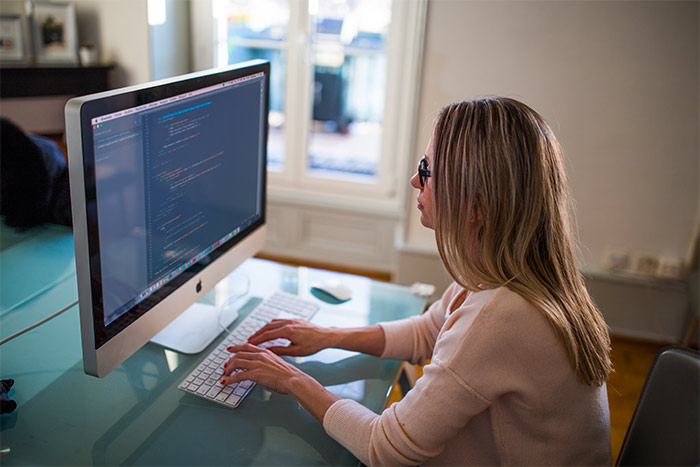Work in the office and at the desk usually means hours of sitting and hardly any movement. This, in the long term, can be physically strenuous on the body itself, as daily sitting for hours is a burden. The lack of exercise mainly leads to problems with the cardiovascular system, which in turn makes long sitting even more difficult. Therefore, especially in people who sit a lot in the office at the desk, and work with the computer, numerous complaints include back pain and tension in the neck and shoulder area. This can be avoided with an ergonomic way of desk working and a little exercise. The way you sit, the chair, the table and even the monitor also play a role. Here are some tips to make your work life healthier.
Move More
For a healthier day at work, it is important to bring enough exercise to your everyday office life, as the human body is anatomically made for exercise and not for long sitting. Also, there are two different problems you may encounter when sitting too long: lack of exercise on the one hand, and the anatomical challenge of sitting on the other.
There are many good ways to exercise at work. Start with riding your bike to the office, which is a healthy alternative and gives your body the necessary movement. If you do not have a bike, you can start with walking to work. If your work is too far from your home, other opportunities for movement include climbing the stairs at work rather than taking the elevator.
Obviously, the possibilities for doing any of the above exercises depend on individual circumstances as well as the possibilities of getting some movement in the office itself. In any case, you should regularly take shorter breaks, in which you can just get up and just walk around or even do some stretching exercises.
It is advisable to get up, at least a little after each hour spent sitting down, and to walk around or stretch out in the office. In practice, there are also a lot of activities where you can get up and walk around, such as making a phone call while you collect your thoughts or work out a concept. Also, conversations and even meetings do not need to be held in a sitting position.
Create An Ergonomic Workplace
An ergonomic office workplace can do a great deal to avoid the risk of back problems and tension. Good office chairs and desk help to keep your posture correct when sitting. Also, an underdesk keyboard drawer relieves strain on the shoulders and wrists.
A good office chair should bring along a lot of benefits to your office health, as we tend to sit for many hours, and it is logically the central factor when it comes to healthy sitting. It should have many different settings options to be able to be customized. This is especially true for the fine tuning of the back, arm or neck rest. The backrest should always have an ergonomic shape. A form that adapts to and supports the natural shape of the back, as well as lumbar support.
In addition, the office chair should not be too small or tight to allow a dynamic sitting. There should also be enough space and freedom of movement around the office chair, and the legs should have some leeway.

Eat Well
Start your day with a healthy breakfast! When the body and brain get new energy, they are more powerful. Fresh fruit, natural yogurt, honey, roasted oatmeal with nuts or wholegrain bread give strength, and the brain can work more productively.
After a balanced breakfast, you feel fit and ready for the day’s tasks. However, after only a few hours the body will need new energy. Choose healthy snacks in between. Fruits and nuts are particularly rich in vitamins and give new strength until the lunch break. Avoid greasy foods or giant portions during your lunch break, but grab a light and wholesome food. Some good lunch ideas include salads and healthy proteins such as fish and lean meat.
Drink Lots Of Water
Do not forget to drink! Already with a loss of water of about two percent, the first signs of decreasing power and tiredness appear. Water, unsweetened tea or a fruit spritzer fill the fluid reservoirs in the body again.
Give Your Eyes Some Relief
Listen to your body during the working day. If your eyes are tired or slip into your papers, then it is time for a break. Have your eyes checked regularly! Especially if you often have dry, itchy eyes and headaches. Headaches, eye pain, and dizziness do not always have anything to do with decreasing fitness or fatigue. For this reason, you need to have regular check-ups, so any illnesses are detected early. Declining eyesight often causes the symptoms mentioned. With adjusted glasses, the symptoms often disappear after a short time by themselves.
Give Your Brain Some Relief
Get up for a walk every hour every hour, as breathing keeps your brain fit. On your break, try not to think about work for a few minutes, but look out the window or think about something relaxing. This way, your brain frees itself from strenuous work tasks, and after a short break, you can start again with full vigour.
Cleanliness And Hygiene
Avoid an unclean workspace by keeping your desk and computers clean at all times. Many people do not actively deal with hygiene and cleanliness in the workplace. But it is still important so that all employees stay fit and healthy. A significant number of bacteria are found on the keyboard and mouse, especially for employees who eat at the workplace. Food leftovers provide a perfect breeding ground for the germs.
Clean the keyboard and mouse regularly and thoroughly with a cleaning cloth. Just doing this once a week can help keep your desk space clean and help you to avoid any unnecessary germs.



